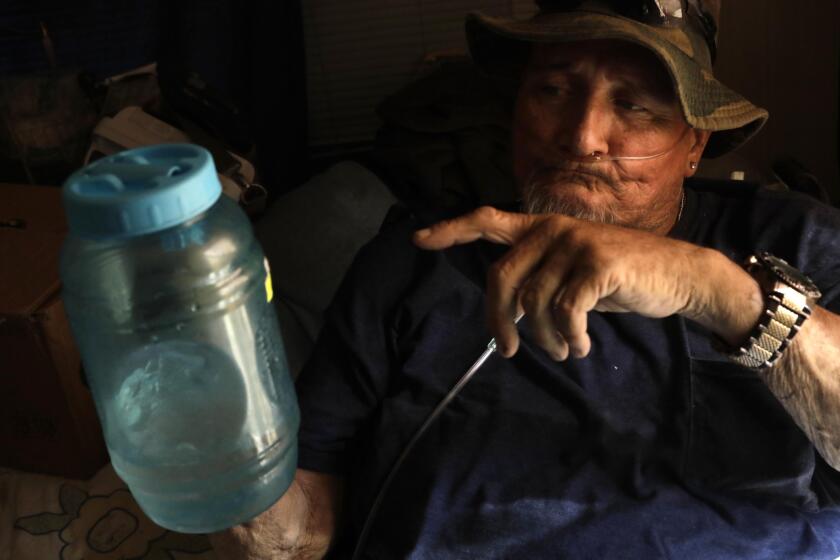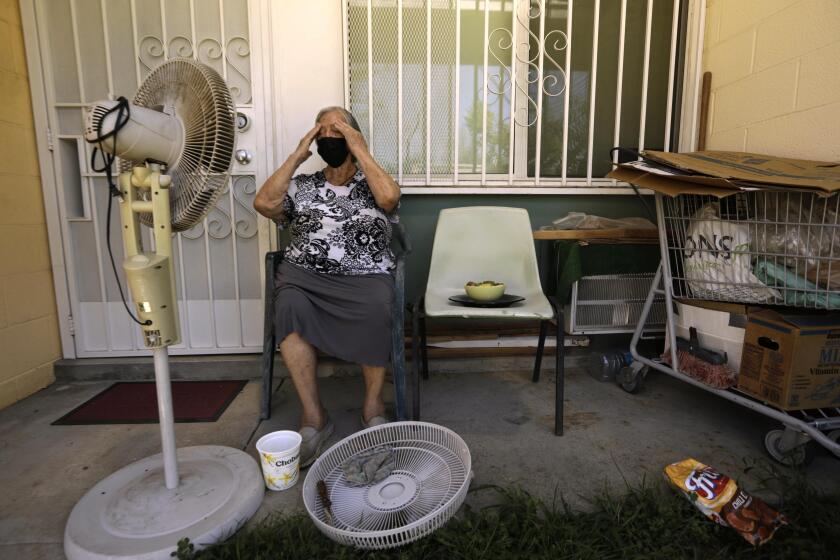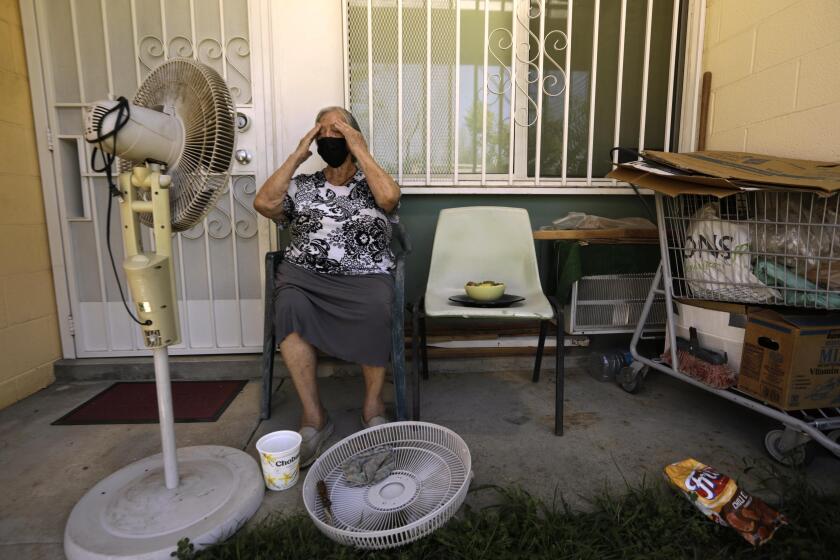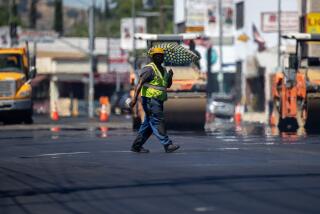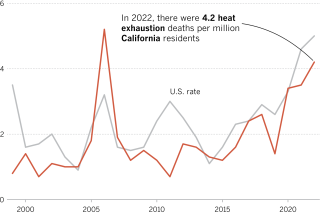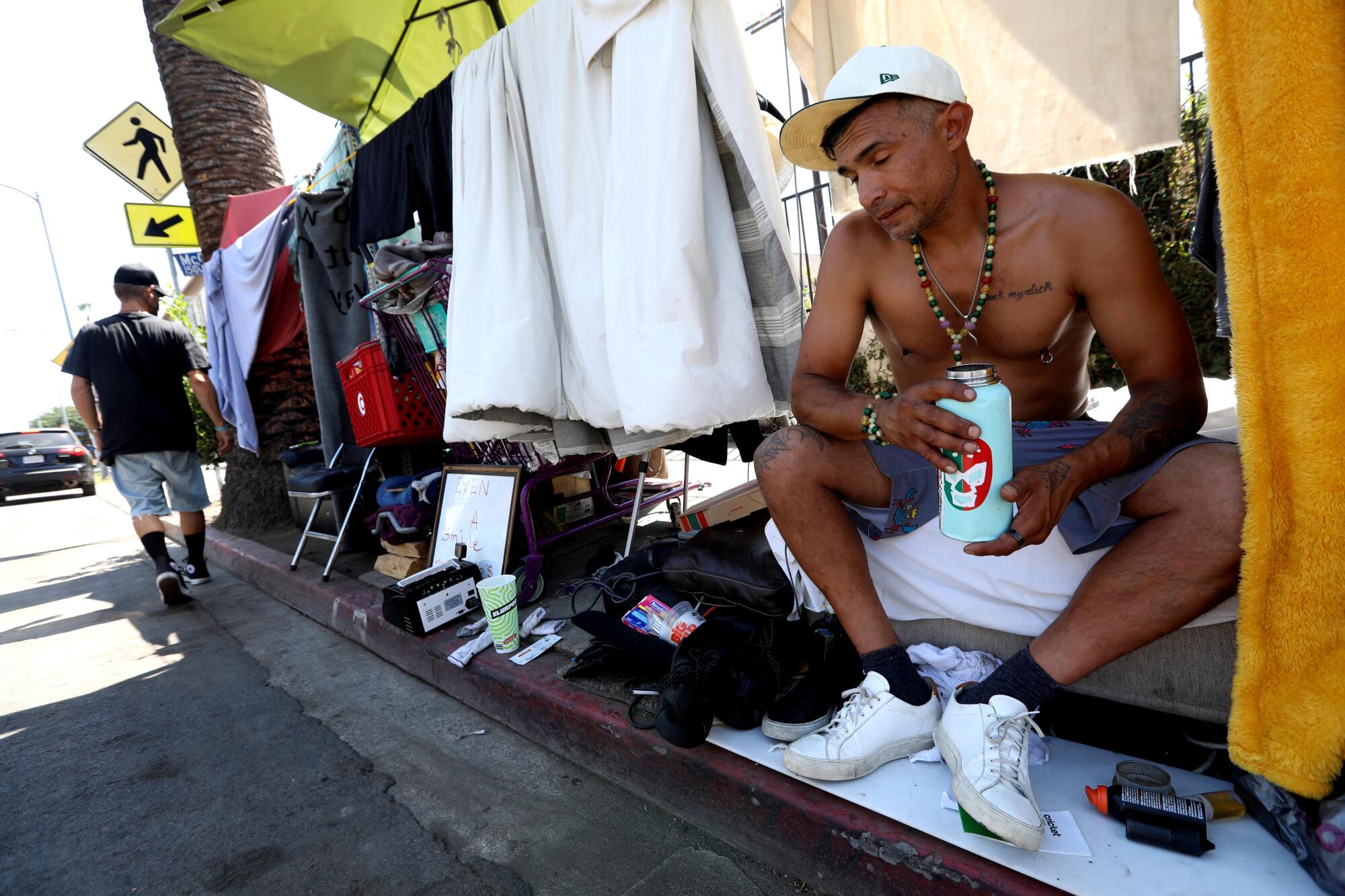
About a week before her son died, Heidi Locatell begged him not to go back to living on the streets.
Luke, 30, had been homeless on and off since around 2015 and struggled with addiction to meth. He had been residing in a sober living facility for nearly eight months but returned to being unhoused on Aug. 31 and relapsed.
“He liked the freedom of nobody telling him what to do,” Locatell said.
As her son hit the streets, Southern California experienced one of the most grueling and intense heat waves of the year. Triple-digit temperatures bore down on the region for days during Labor Day weekend. The city opened nine cooling centers and added two more, but few people used them.
On Sept. 7, a driver found Luke passed out on a sidewalk, according to a Los Angeles County coroner’s report obtained through a public records request. By the time he was taken to Sherman Oaks Hospital, his temperature was 108 degrees.
He died two days later.
Read all of our coverage about how California is neglecting the climate threat posed by extreme heat.
Although the unhoused population represents about 70,000 of Los Angeles County’s more than 9.8 million people, they accounted for nearly half — 5 in 12 — of deaths from heat illness or heat exposure last year, according to data from the coroner’s office. Half of those deaths occurred during August’s blistering “heat dome” or in the days immediately after.
Fire departments in L.A. County responded to 146 calls classified as “heat” or environmental hyperthermia between Aug. 31 and Sept. 9, according to the L.A. County Department of Health Services, which operates the Emergency Medical Services agency and county hospitals. In comparison, there were 10 calls in the previous 10-day period.

Heidi had no idea about her son’s fate. The day he died, she got a letter from him — postmarked three days before — apologizing for his “attitude” and “uncivilness” toward her.
“I will be in touch soon, please accept this apology,” he wrote. “I hope you are coping with this weather also. Maybe gardening? Just a suggestion.”
Heidi felt relieved. She had frantically been trying to get in contact with Luke to no avail. She thought that the letter meant that he was safe and just having issues with his phone.
California chronically undercounts the death toll from extreme heat, which disproportionately harms the poor, the elderly and others who are vulnerable.
Then, on Sept. 30, more than three weeks after he was discovered lying on the broiling sidewalk, she found out he was dead. He had been diagnosed with heatstroke with altered mental status, acute kidney injury and acute respiratory failure, among other conditions. The cause of death was listed as hyperthermia and the effects of methamphetamine use.
“He baked,” Heidi said.
It was rare for a coroner to cite heat as a lethal factor, even though it often is.
Heat-related illness and death are “notoriously” undercounted because patients in emergency rooms are frequently diagnosed with other medical conditions, such as dehydration and kidney failure, without any mention of their high temperatures and exposure to heat, according to David Eisenman, a professor specializing in climate change at the UCLA Fielding School of Public Health.
“California needs a system that’s going to track these heat-related hospitalizations and deaths and can’t rely on just the physicians looking for heat-related illness, because that’s not going to capture all of them,” he said.
Although deaths often surge during heat waves, the data don’t reflect the connection to the weather, said Larry Kalkstein, the president of Applied Climatologists, which performs research on applied climatological issues.
Paved surfaces, tree cover, and home construction quality can make the difference between heat waves being an inconvenience or a threat to your life.
“If someone dies of a heart attack, stroke or respiratory failure during a heat wave, it’s virtually impossible to prove that the heat was a cause,” he said. “So it is not listed as such. Nevertheless, these three causes of death spike during a heat event.”
Indeed, the reason Heidi Locatell did not learn of her son’s fate for so long, she said, was that the coroner told her there were so many deaths “that they couldn’t process them to get to me in a timely manner.” Only six were listed as heat-related.
Kalkstein estimates an average annual of 1,500 to 2,000 heat-related deaths in the U.S. — more than from any other weather event, including hurricanes, tornadoes, lightning and snowstorms.
A Times investigation published in 2021 found that California has severely undercounted the number of people who die every year due to extreme heat and has failed to provide resources to communities most vulnerable to climate change and the effects of heat events.
The California Department of Public Health wasn’t able to provide statewide numbers for heat-related deaths during the 2022 Labor Day heat wave but said those results will be available in April, attributing the lag time to such deaths taking months to determine the cause.
The move would raise awareness of the deadly effects of extreme heat events, which experts say kill more people than any other climate-driven hazard.
The effects of climate change have exacerbated heat-related deaths over the years, Eisenman said, creating longer, more frequent and more severe heat waves that come earlier and end later in the season.
“Right now, if it gets hot during the day, you count on the nights as cooling time, and if you don’t get that cooling time, your body gets overheated much more easily,” he added. “Those nighttime lows are going to rise, and we’re going to see that happening all across California.”

About 150 people die every day in L.A. County during the summertime, but during an extreme heat event the deaths increase by 8% to 30%, according to Edith de Guzman, a UCLA researcher and director of the Los Angeles Urban Cooling Collaborative.
“Folks who already have preexisting conditions, whether that be diabetes, kidney and heart conditions or even mental health conditions, their body is already allocating much of its energy to deal with those underlying conditions,” she said. “People who are exposed environmentally to that heat, it doesn’t allow their body to recover or to have a break.”
Homeless people are particularly vulnerable during heat waves because they’re more likely to have preexisting medical conditions and find it harder to stay hydrated and out of the sun. And because a large swath of them are afflicted by mental illness, some might be taking medications that affect their ability to regulate their body temperature.
“When you’re in a tent, when the sun is shining, it’s like a greenhouse,” De Guzman said. “You may be in a somewhat shaded environment, but it’s actually magnified in a tent and ... even worse than being outside.”
What are heat-related illnesses and how are they treated? Are they preventable or inevitable? We talked to health experts for the answers.
On Sept. 7, James Richard Armstead Jr. was found dead inside his tent in Queen Anne Park in Los Angeles, according to a coroner’s report.
Armstead, 55, was homeless and struggled with high blood pressure and strokes. He drank socially but didn’t use illicit drugs or smoke in the last year, according to his family. He was found unresponsive by park maintenance staff and was pronounced dead at the scene by first responders.
His death was ruled “heat-related” due to “temperatures reaching 102 degrees.”
That same day, 35-year-old Younus Hakim, who was unhoused, was found in a Reseda parking lot by the manager of a nearby gas station, according to a coroner’s report. Hakim had a history of alcohol use and seizures.
Hakim was also pronounced dead at the scene. His death was ruled accidental because of environmental heat exposure. Temperatures in the area had reached a high of 104 degrees that day.
More than a quarter of the lives lost during heat waves could have been saved if cities implemented measures to provide tree canopy, vegetation and reflective materials in roofing, sidewalks and other infrastructure, according to a March 2022 article co-written by De Guzman. Temperatures during heat waves could be reduced by 2 to 3 degrees using these strategies during the hottest times of the day and overnight.
Justin Thomas, 34, who lives in a tent on skid row, knows two homeless people who died on hot days last year. One passed away in April and the other in October. Neither of them was listed among the heat-related deaths provided by the coroner.
“They weren’t really taking care of themselves like they should have,” Thomas said. “One of them was dealing with mental illness. I really think that they gave up.”
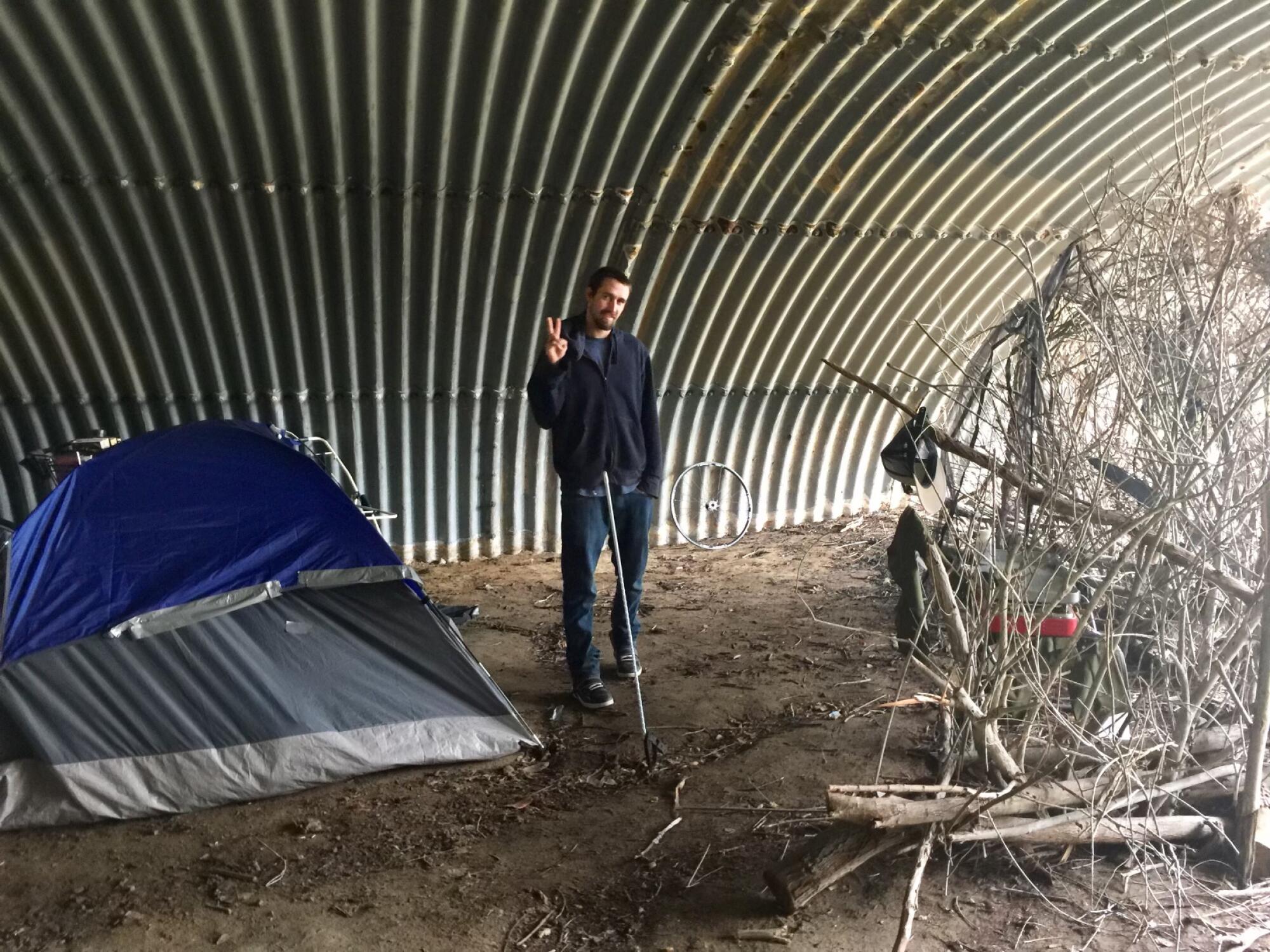
Troy Vaughn, president of Los Angeles Mission, a homeless shelter on skid row, said he’s seen or heard about an uptick in the number of homeless people who die every year during heat waves.
“Homelessness has become more pervasive, and what I mean by that is that it’s in our faces all the time,” Vaughn said. “It’s part of every conversation, and that’s because we have not done, as a society, a good job in creating pathways for individuals to access housing.”
Vaughn said during the summer months, Los Angeles Mission acts as a cooling center, and volunteers focus on handing out water and other resources to the unhoused population.
“The longer people are homeless, the harder it is for them to get off the street,” Vaughn said.
He said that being unhoused can become a “lifestyle and a community” that keeps many of them rooted to a specific area and allows them to feel they have some control over their lives.
During an extreme heat event, unhoused people are more likely to utilize resources that are already part of their daily routines, such as grocery stores and libraries, rather than travel to a cooling center in an unfamiliar place, according to Sherin Varghese, an organizer for Ktown for All, a homeless outreach and advocacy group.
“Because of exposure to the elements, people who are homeless are going to continue to be at the front lines of issues related to climate change,” she said. “They’re absorbing the impact to a greater degree.”
A Times analysis revealed that after the city opened up the cooling centers — air-conditioned facilities with expanded hours during heat emergencies — during the 10-day heat wave, about 2,256 Angelenos used them, amounting to about 21 people per center per day, for a city with nearly 4 million residents.
Although many homeless people will seek relief in fast-food restaurants and coffee shops, private businesses will often act hostile toward them, even during a heat wave, Varghese said.
“In general, a lot of places will kick people out,” she said. “It’s based on how they look and their ability to buy items. A lot of people are refusing bathroom access, and people are just forced to leave.”
Thomas, the homeless person living on skid row, said that during heat waves he usually tries to order a cold drink at Starbucks so he can stay indoors as long as he can. He also tries to disguise that he’s homeless.
“Most places you can’t take all of your stuff with you,” he said. “Once they see you with two to three full bags, they automatically know and won’t let you in. You have to pretend you aren’t homeless. That’s mainly the hardest part.”
Luke Locatell’s drug use began with marijuana at age 15, around the time when he found his father dead in his New Jersey apartment from a drug overdose. Luke was sent to Hyde School, a boarding school in Maine, where he “flourished,” his mother said. He enrolled in La Salle University but was kicked out after an incident involving drugs.
Then, he tried meth for the first time and was quickly hooked.
“He just really liked the way it felt,” Heidi Locatell said. “He always said to me, ‘You know, Mom, I just do drugs recreationally, just like you have a glass of wine or a cup of coffee. Everybody’s addicted to something.’”
Luke moved back in with his family but started becoming “belligerent” and getting into altercations with his siblings. He would smoke meth in the garage and refused to get help or enroll in addiction programs. He cycled through jail multiple times.

“So I put him out,” Heidi said. “And it was the hardest decision of my life. But he was eating us alive.”
About a month before Luke died, he got a job laying down high-speed internet cable in San Diego. Heidi warned him about the heat.
“I said, ‘Luke, this heat is not to be trifled with,’” she said. “You have to keep your fluids going at all times. You’ve got to, like, drink Gatorade that’s going to keep your electrolytes going. If you’re going to do anything athletic outside, you have to drink like two gallons of water the night before or the day before.”
“Oh, Mom, I know,” he said. “Oh God, you’re such a worrywart.”
More to Read
Start your day right
Sign up for Essential California for news, features and recommendations from the L.A. Times and beyond in your inbox six days a week.
You may occasionally receive promotional content from the Los Angeles Times.
